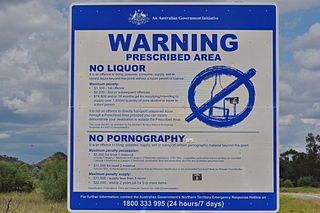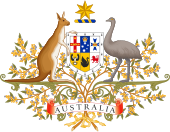Native title is the set of rights, recognised by Australian law, held by Aboriginal and Torres Strait Islander groups or individuals to land that derive from their maintenance of their traditional laws and customs. These Aboriginal title rights were first recognised as a part of Australian common law with the decision of Mabo v Queensland in 1992. The doctrine was subsequently implemented and modified via statute with the Native Title Act 1993.

The second question of the 1967 Australian referendum of 27 May 1967, called by the Holt government, related to Indigenous Australians. Voters were asked whether to give the Commonwealth Parliament the power to make special laws for Indigenous Australians in states, and whether Indigenous Australians should be included in official population counts for constitutional purposes. The term "the Aboriginal Race" was used in the question.
The Wave Hill walk-off, also known as the Gurindji strike, was a walk-off and strike by 200 Gurindji stockmen, house servants and their families, starting on 23 August 1966 and lasting for seven years. It took place at Wave Hill, a cattle station in Kalkarindji, Northern Territory, Australia, and was led by Gurindji man Vincent Lingiari.
The Central Land Council (CLC) is a land council that represents the Aboriginal peoples of the southern half of the Northern Territory of Australia (NT), predominantly with regard to land issues. it is one of four land councils in the Northern Territory, and covers the Central Australia region. The head office is located in Alice Springs.

The Native Title Act 1993(Cth) is a law passed by the Australian Parliament, the purpose of which is "to provide a national system for the recognition and protection of native title and for its co-existence with the national land management system". The Act was passed by the Keating government following the High Court's decision in Mabo v Queensland (No 2) (1992). The Act commenced operation on 1 January 1994.
The Gurindji are an Aboriginal Australian people of northern Australia, 460 kilometres (290 mi) southwest of Katherine in the Northern Territory's Victoria River region.

Aboriginal title is a common law doctrine that the land rights of indigenous peoples to customary tenure persist after the assumption of sovereignty to that land by another colonising state. The requirements of proof for the recognition of aboriginal title, the content of aboriginal title, the methods of extinguishing aboriginal title, and the availability of compensation in the case of extinguishment vary significantly by jurisdiction. Nearly all jurisdictions are in agreement that aboriginal title is inalienable, and that it may be held either individually or collectively.
Mintabie is an opal mining community in the Anangu Pitjantjatjara Yankunytjatjara in South Australia. It was unique in comparison to other communities situated in the APY Lands, in that its residents were largely not of Aboriginal Australian origin, and the land had been leased to the Government of South Australia for opal mining purposes since the 1980s.

The Anangu Pitjantjatjara Yankunytjatjara Land Rights Act 1981 grants certain land and other rights to the Anangu Pitjantjatjara Yankunytjatjara in South Australia. It began its life as the Pitjantjatjara Land Rights Act and commenced operation on 2 October 1981. Its long name title is "An Act to provide for the vesting of title to certain lands in the people known as Anangu Pitjantjatjara Yankunytjatjara; and for other purposes". The Act has since had several amendments, the latest in 2017.

The Northern Territory National Emergency Response, also known as "The Intervention" or the Northern Territory Intervention, and sometimes the abbreviation "NTER" was a package of measures enforced by legislation affecting Indigenous Australians in the Northern Territory (NT) of Australia, which lasted from 2007 until 2012. The measures included restrictions on the consumption of alcohol and pornography, changes to welfare payments, and changes to the delivery and management of education, employment and health services in the Territory.
Australian heritage laws exist at the national (Commonwealth) level, and at each of Australian Capital Territory, New South Wales, Northern Territory, Queensland, South Australia, Tasmania, Victoria, Western Australia state and territory levels. Generally there are separate laws governing Aboriginal cultural heritage and sacred sites, and historical heritage. State laws also allow heritage to be protected through local government regulations, such as planning schemes, as well.
Land councils, also known as Aboriginal land councils, or land and sea councils, are Australian community organisations, generally organised by region, that are commonly formed to represent the Indigenous Australians who occupied their particular region before the arrival of European settlers. They have historically advocated for recognition of traditional land rights, and also for the rights of Indigenous people in other areas such as equal wages and adequate housing. Land councils are self-supporting, and not funded by state or federal taxes.
Muckaty Station, also known as Warlmanpa, is a 2,380-square-kilometre (920 sq mi) Aboriginal freehold landholding in Australia's Northern Territory, 110 kilometres (68 mi) north of Tennant Creek, and approximately 800 kilometres (500 mi) south of Darwin. Originally under traditional Indigenous Australian ownership, the area became a pastoral lease in the late 19th century and for many years operated as a cattle station. It is traversed by the Stuart Highway, built in the 1940s along the route of the service track for the Australian Overland Telegraph Line. It is also crossed by the Amadeus Gas Pipeline built in the mid-1980s, and the Adelaide–Darwin railway, completed in early 2004. Muckaty Station was returned to its Indigenous custodians in 1999.
Aboriginal land councils in the Northern Territory are representative bodies known as land councils, covering four areas of Aboriginal self-governance in the Northern Territory of Australia.
Commonwealth, State, and Territory Parliaments of Australia have passed Aboriginal land rights legislation.
In Australia, Indigenous land rights or Aboriginal land rights are the rights and interests in land of Aboriginal Australians and Torres Strait Islander people; the term may also include the struggle for those rights. Connection to the land and waters is vital in Australian Aboriginal culture and to that of Torres Strait Islander people, and there has been a long battle to gain legal and moral recognition of ownership of the lands and waters occupied by the many peoples prior to colonisation of Australia starting in 1788, and the annexation of the Torres Strait Islands by the colony of Queensland in the 1870s.
The Stronger Futures policy was a multifaceted social policy of the Australian government concerning the Aboriginal population of the Northern Territory. It was underpinned by the Stronger Futures in the Northern Territory Act 2012, which ceased 10 years after its commencement on 29 June 2012.
In Australia, an Aboriginal land trust (ALT) is a type of non-profit organisation that holds the freehold title to an area of land on behalf of a community of Aboriginal Australians. The land has been legally granted to a community by the government under a perpetual lease, usually after the community makes a formal claim of traditional ownership. Land granted under Aboriginal title is inalienable; it can not be bought, sold, traded or given away. The land trust is the organisation appointed by the community to legally hold the title deeds. The land trusts are administered by Aboriginal land councils.
The Katiti Aboriginal Land Trust is a land trust for a block of land in the southwest of the Northern Territory of Australia located in the locality of Petermann. It was created through the Katiti Land Claim in 1980. The trust's owners include Pitjantjatjara, Yankunytjatjara and Luritja people. The block of land is officially referred to as Northern Territory Portion 1818. It borders the larger Petermann Land Trust area and Uluṟu–Kata Tjuṯa National Park to the north and west, and two pastoral stations to the east and south: Curtin Springs and Mulga Park. The town of Yulara is excluded from the Land Trusts, and sits between the Katiti block and Uluṟu–Kata Tjuṯa National Park.
The Aboriginal Areas Protection Authority (AAPA) is an independent statutory authority established under the Northern Territory Aboriginal Sacred Sites Act 1989. Its function is to protect Aboriginal sacred sites within the Northern Territory of Australia.





